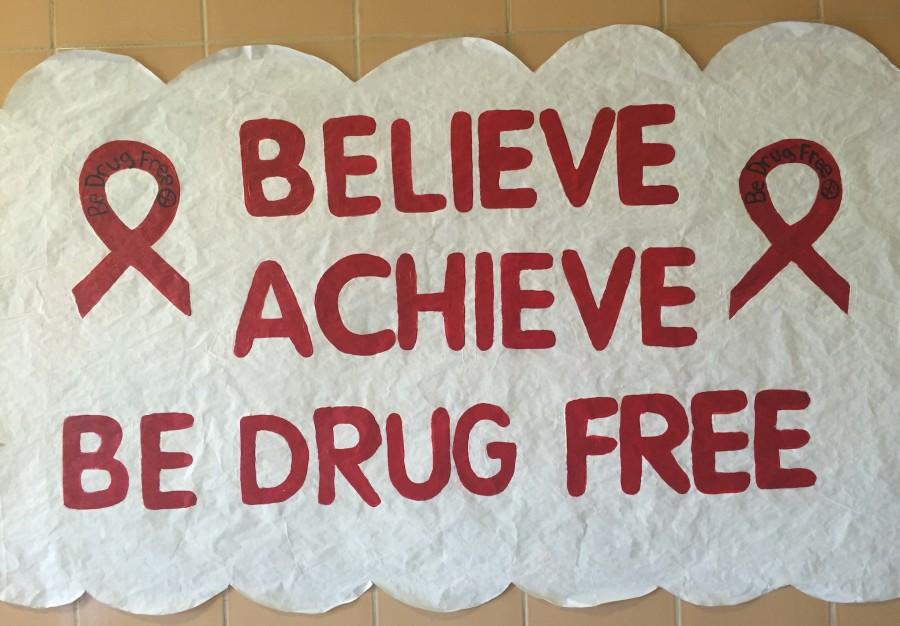Red Ribbon Week
Poster in the main building celebrating Red Ribbon Week (Gaby Hernandez / Lincoln Lion Tales)
The crushing reality of substance abuse is anything but glamorous; it is an all-too-real issue that affects countless people worldwide. To aid the battle against this problem, October 23-31 has been dedicated as red ribbon week.
The red ribbon campaign began in 1988, after the murder of American DEA agent Enrique Camarena in Mexico sparked nationwide outrage. After this event gained widespread recognition, citizens demanded change. To honor Camarena, people in his California hometown began wearing red ribbons as a symbol of the fight against drug trafficking and drug abuse. This tradition continues even now, with red ribbon week being celebrated in nearly all parts of the country.
Today, the fight against drugs is far from over. The global drug trade is estimated to be worth around $435 billion, and accounts for half of all income made from organized crime. Drug wars have also resulted in the death of over 60,000 people in the years between 2006 and 2012 alone. The underground narcotics market proves time and time again to be an extremely profitable business, with a large consumer audience. Controlling the market and hindering its growth prove to be incredibly difficult tasks for government forces, as well. With a readily available supply of drugs on the market and a steadily-growing demographic of users, the industry continues to thrive everyday.
The effects of this trade are felt worldwide, with nations like France, Iran, and the UK leading the world in drug use. Distributors are able export their products to other countries by bribing government officials or expertly smuggling them across national borders.
Here in the United States, one of the most commonly used substances is marijuana. Nearly half of all Americans admit to having tried it once or more. Many states like Colorado and Oregon have already legalized the recreational use of marijuana, and others are headed down a similar path.
While not viewed in the same light as cocaine or methamphetamine, constant use of the drug is not without its consequences. There is still debate over the long-term effects of smoking marijuana, but some studies have reported that it can have negative effects on lung-health, immune system function, and even libido. That said, marijuana is still significantly less harmful to the body than tobacco, which can be legally purchased nearly anywhere in the United States. A source who wishes to remain anonymous confirmed that on a scale of 1 to 10–with 10 being the easiest–“getting drugs is an 8 1/2.”
For some, marijuana is a necessity in everyday life. In the medical field, it is often used to treat illnesses such as multiple sclerosis, epilepsy, and bipolar disorder. It remains banned in many states, but its medicinal properties have prompted a number of states to adopt laws allowing marijuana access for patients with special needs.
The trend of “vaping” is also a response to the rapidly increasing number of health-conscious smokers. It attempts to give users the experience of smoking without the danger of inhaling the toxins in actual smoke, and is popular with many demographics. Regulations concerning the use of “vape pens” vary from state to state, and have been the subject of much discussion.
With the progression of time comes the growth of the drug industry and its far-reaching arms. Everyday, someone will become addicted for the first time. For many first-time users, this experience is exciting and new. Over time however, continued use often leads into addiction as their bodies become dependent on these drugs. The cravings for a release of dopamine become stronger, and–as the body builds up a tolerance–more drugs are required to satisfy the hunger for a high. This desire becomes so powerful that when addicts try to stop, they often go through a violent withdrawal that includes symptoms such as vomiting, paranoia, and self-harm.
It is commonly believed that many people turn to drugs to cope with other problems in their lives, and that drug users live reckless, immoral lives. However, for a large number of the drug user population, their reasons for using drugs are much simpler.
“I smoke [weed] 6 days a week…because I can,” said the anonymous source.
Many rehabilitation programs exist to help recovering drug addicts, but they are extremely costly, and even those covered under health insurance cannot always expect treatment to be affordable. Those who cannot receive treatment for their illness are left with few options. In some cases, addiction can lead to homelessness, or crime. It is estimated that nearly half of all homeless people struggle with some form of substance abuse. The percentage of prisoners doing time for drug-related offenses is also estimated to be around 48.4%.
Immoral as it may be, common practice seems to be this: ignoring those with serious addictions. For most people, the topic is a taboo. However, as awareness of substance abuse increases, it becomes increasingly difficult to disregard the number of problems associated with narcotics. In the past, media coverage of stars like Amanda Bynes and Lindsay Lohan painted the raw portrait of drug abuse, but their subsequent recoveries serve as an example of how proper rehabilitation can save lives. Unfortunately, it is much more common to see stories of celebrity deaths that occur as a result of overdose, a headline too often seen in Hollywood. Even with the money and resources to receive care for their addiction, many stars can fall victim to substance abuse. For the average folks out there, the road to recovery is even more perilous.
While red ribbon week lasts from October 23-31, action can be taken in everyday life to combat drug abuse. It is up to every individual to make wise choices; whether that be to abstain from using drugs completely, or to use them in moderation. As 2015 draws to a close, let it be a year when fewer lives are lost to this terrible condition.

Chau moved from Saigon to San Jose in the early 2000s and has been a Bay Area local for over 14 years. As a senior, she participates in the school’s...











